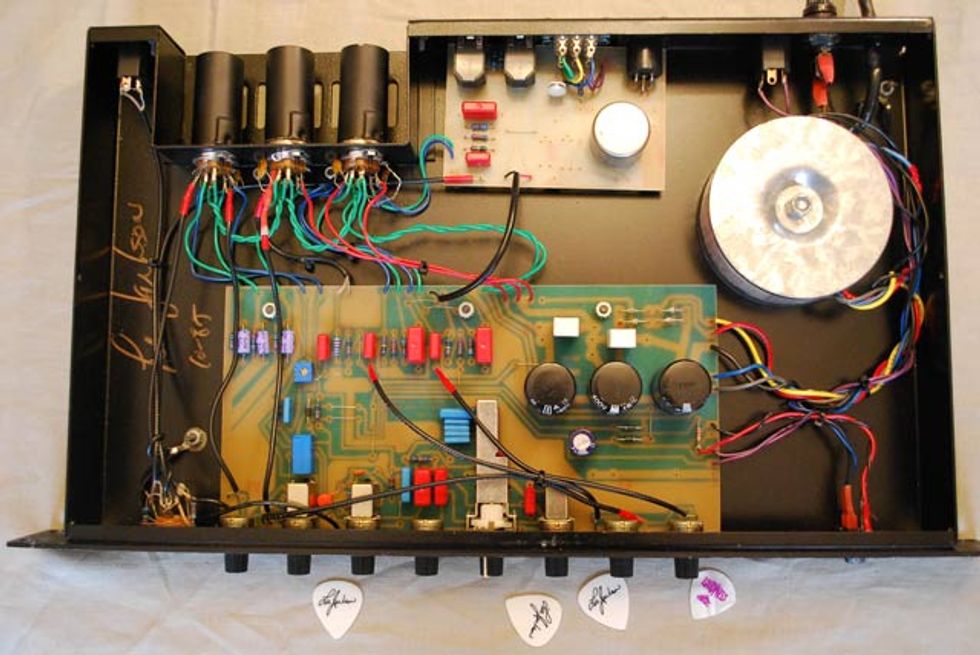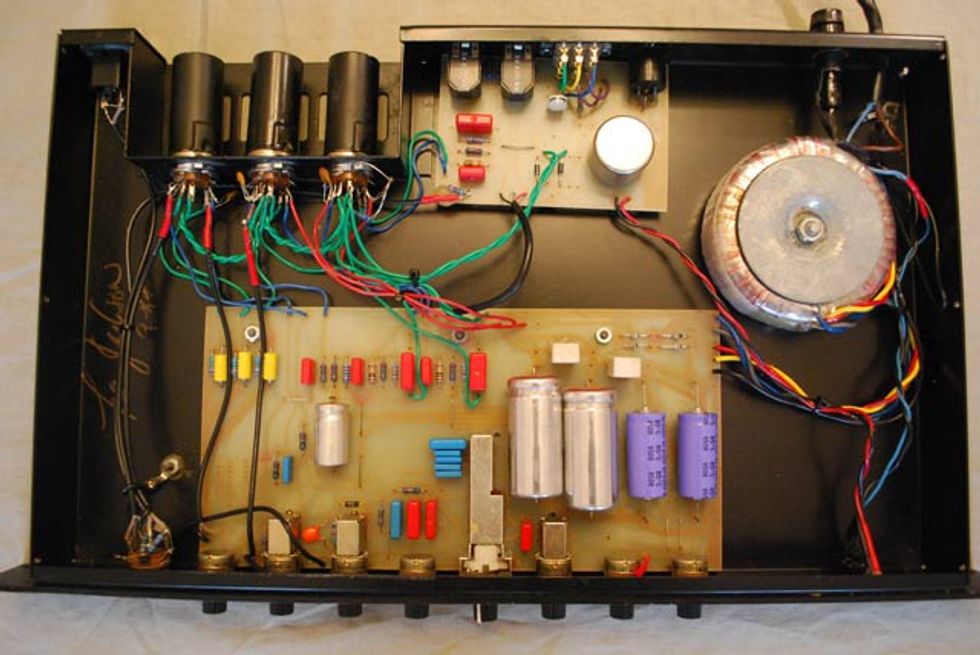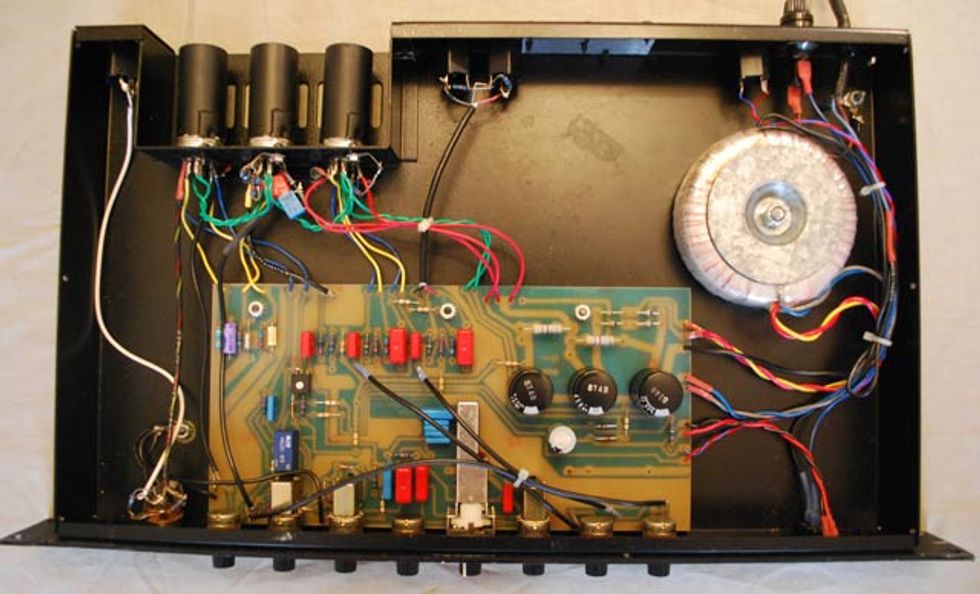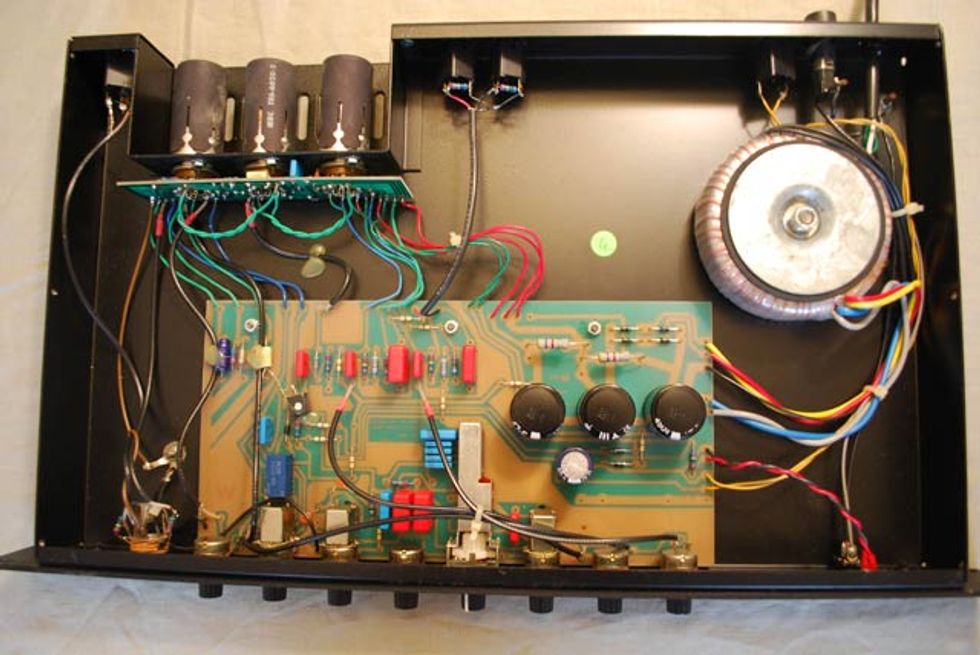Exploring the differences in years of the GP-1000 and the preamp''s evolution
| More on the GP-1000 Click here to read the first part of our interview with Lee Jackson on the history of the unit. Click here to jump to photos of the insides of the different units at the end of this interview. |
What details can you provide about the modifications from the ’87, version one, to the ’88, version two?
Because we made way more modified Marshall-style GP-1000s than the Fender-style, we would convert the Marshall-style GP-1000s to the Fender-style, like we did for Scott Henderson. Allan Holdsworth uses the Fender-style GP-1000. It’s hard to remember all the artists that we modded GP-1000s for—it really took off when I changed the circuit to the modded Marshall-style. We probably only made two to three hundred of the Fender-style and thousands of the Marshall-style.
Can you describe the “transition model,” that is, the late ’87 model with components assembled to the tube socket and blanked-over balanced outputs? Would you elaborate on this change from the ’87 to Marshall-y ’88?
I was trying to move as fast as the market was moving, plus at this time Metaltronix was expanding fast. I was hiring more and more employees and now had a sales force. One of the things a sales force does is try to move product. One day during one of our sales meetings, my sales team informed me because of my popularity with modified Marshalls that everyone they were calling, music stores, wanted my modified Marshall sound and not the Fender sound.
So, I quickly went to my lab and started designing a change to the GP-1000 that would satisfy that need. I had parameters that I needed to stay in, like the number of tubes, controls, power transformer etc., especially if we were going to make the change on the next production run. I needed more gain stages, and the only place I could get it was from the tube-driven XLR balanced out, so away it went. On the first batch, we put a metal plate over the holes until the new metal arrived, when it was removed all together.
Speaking of making the most of available gain stages, a Marshall-type cathode follower tone circuit was not employed. Was this to save gain stages or in order to be more faithful to a Fender circuit? Or was it something else?
I have found that every circuit changes the sound. I really liked the way the Fender tone circuit sounded in the GP-1000, and I didn't want to change it.
Your use of WIMA caps and metal film resistors was definitely ahead of its time. Can you comment on that?
I have never been a follower. I really don’t even pay attention to other designers. When I was designing, I always looked for the best possible components in the world. It didn’t matter the cost or what I had to go through to get them. WIMA caps were just so much more musical than any of the other possibilities that were available to me, and because of the extremely high gains I was dealing with, I needed quiet resistors.
An interesting difference between the ’88 models and the ‘87s is the tone stack capacitors: The '88 has a .1uF midrange capacitor and a .2uF bass capacitor as part of the tone stack. The '87s have the Fender spec .047 and .1 respectively. This ’88 spec seems rather innovative… and sounds really good!
On this, I was experimenting with shifting the frequency response of the tone controls down. At the factory I had a GP-1000 with the ability to easily change components in and out, and I would work with the sale team, ask them what they wanted and we would experiment right there with the GP-1000 until the team was happy. That is also how the SP-1000 power amp came about: one of my sales guys, Scott, came in one day and said, “What is that you’re plugging the GP-1000 in on your bench?” I said that it was my bench amp, which was a power amp I made to test GPs with. He then said that we needed to make those and sell them with the GPs. The trick behind the SP-1000 was that it had 10 percent distortion, compared to all the other solid-state power amps on the market, which were .001 percent.
There are also different capacitor values for the output caps. I assume you were attempting to obtain greater stereo imaging.
Stereo was the new buzzword, and that’s why there are two outputs, and because of that I was looking for ways to increase the sonic spread, so I used the different values on Output One and Two. Output Two has a slightly increased bass response.
Unfortunately, there have been complaints that push/pull switches don’t do much. Are there any modifications that can be made for a more dramatic effect?
The short answer is no. The tone controls on the GP-1000 are both a blessing and a curse. Over my years of designing, I have found that tone control placement makes such a drastic difference in the overall sound of a preamp or amplifier. I was looking for a great overall tone moreso than controls that made drastic differences or changes. The GP-1000 tone controls are in the first stages and they pre-shape the tone before the distortion, like early Fenders do. The problem is that once the preamp is set into saturation the tone controls do less and less. Changing the position of the tone control circuit would hurt the magic of the GP-1000.
The GP-1000 uses a torroidal transformer. What’s the reason for that particular choice?
One of the things you need for a great tube preamp is high voltage. You’re only fooling yourself if you think you’re going to get that great tube overdrive at lower voltages. I needed a way to get a high voltage and a lot of current in a small place without spraying so much RF that everything in its vicinity would buzz, or melt from extreme heat. The best candidate was the torroidal.
What preamp tubes were used in the original shipped models? What do you recommend?
The original and the only tube we used on the GP-1000s were the original Chinese 12AX7s. We had to test hundreds of them and get the quietest ones for production. The Chinese 12AX7 is a great sounding tube—they just had bad production skills, and we threw out more than we used. It’s the same now: the Chinese 12AX7 is still available and I have found they’re just as bad, but when you get a quiet one, they sound great.
As for suggestions, because the GP-1000 is a preamp, the tubes do make a big difference, and it really makes a difference to your playing style. I’m really liking the new Tung Sol 12AX7s. They are little darker sounding. If you want a little brighter sound, I like the Electro-Harmonix 12AX7EHs. And of course, if you have any NOS around, I heard a couple of GPs with [Amperex] Bugle Boys in them that didn’t sound bad.
Will you ever come out with a Service/Modification DVD for the GP-1000?
Yes, I will. I have been so busy with designing new products I haven’t gotten around to doing one. I will, I promise.
leejackson.com

The first shipped GP-1000, serial number 870001.

The ’87 model GP-1000, serial number 870073, used by Reb Beach on the Winger demos. This is an early version of which less than 100 were made, characterized by the lack of a channel-switching jack on the rear of the unit, as well as the lack of a switching relay.

A late-’87 “transition” model GP-1000, serial number 870351. The Balanced Out on the back panel was blanked-over, and it had electronic components assembled directly to the tube sockets.

This GP-1000, serial number 880790, is the 1988 model.